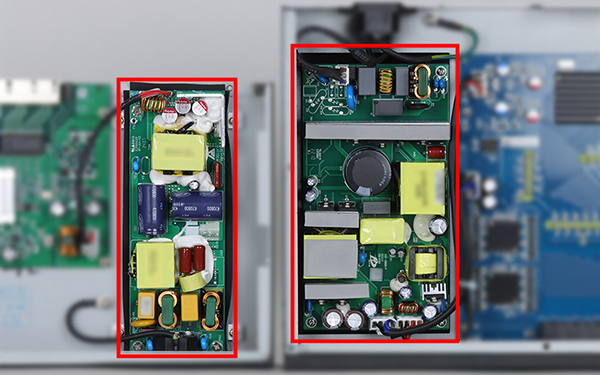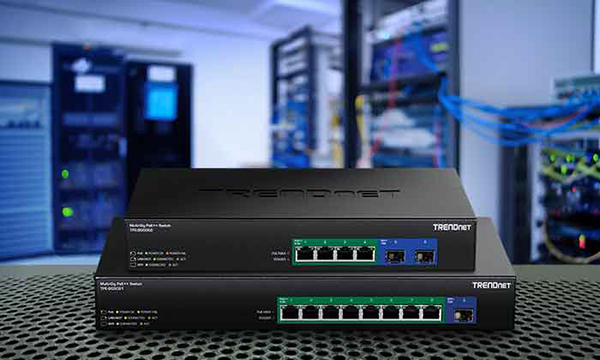GaN Power Technology & Networking Solutions
April 2025

GaN power technology allows for more power in a smaller form factor, this means power is delivered with increased efficiency while producing a smaller overall carbon footprint. This can be especially useful for GaN power network switches and GaN power supplies.
GaN is short for gallium-nitride, a semiconductor compound used for inside variety of electronic devices. It has a wider bandgap compared to silicon, giving many advantages including, efficiency, size, temperature, voltage, speed, and radiation tolerance.
GaN power technology enhances power devices by improving power density, reducing size, boosting thermal performance, and increasing energy conversion efficiency. This leads to more compact power supplies with superior power delivery. A GaN power supply can have up to 40 percent less footprint than traditional models. Additionally, the higher power efficiency reduces the heat generated within the power supply, often eliminating the need for cooling fans.
GaN is short for gallium-nitride, a semiconductor compound used for inside variety of electronic devices. It has a wider bandgap compared to silicon, giving many advantages including, efficiency, size, temperature, voltage, speed, and radiation tolerance.
GaN power technology enhances power devices by improving power density, reducing size, boosting thermal performance, and increasing energy conversion efficiency. This leads to more compact power supplies with superior power delivery. A GaN power supply can have up to 40 percent less footprint than traditional models. Additionally, the higher power efficiency reduces the heat generated within the power supply, often eliminating the need for cooling fans.
GaN Benefits
GaN power technology offers unparalleled benefits and advantages, enabling more efficient, compact, and high-performance power systems. It is transforming a wide-range of industries, including consumer electronics, industrial applications, and energy conversion, and also products, such as GaN power PoE switches. Ultimately, GaN technology enables the next generation of more efficient and sustainable technologies.
Efficiency & Power Density
GaN is more efficient at converting power, reducing power loss by up to 80% in power converters. This is because GaN devices have lower on-resistance compared to traditional silicon transistors. GaN devices also have the ability to have a higher voltage tolerance and to handle high current density in smaller packages, allowing for more powerful systems to be delivered within compact spaces.
Operating at high frequencies with low switching loss make GaN power technology perfect for AC-to-DC power supplies, and DC-to-DC converters, leading to better power conversion efficiency. GaN also helps to improve PFC (power factor correction), and to reduce distortion. This is a more effective way of using energy, and provides less stress on the electrical grid.
Switching Speeds
GaN transistors offer faster switching than traditional silicon devices. Faster switching capabilities make GaN devices ideal for critical applications like radio frequency, power supplies, and GaN power network switches. The faster switching times also allow GaN devices to operate with lower switching losses.
Size & Form Factor

GaN allows for smaller, lighter systems by packing more power into smaller spaces. This is especially important for things like power supplies, telecommunications, and automotive applications, where space can be limited.

GaN allows for smaller, lighter systems by packing more power into smaller spaces. This is especially important for things like power supplies, telecommunications, and automotive applications, where space can be limited.
Temperature
In general, GaN devices tend to be more thermally efficient, generating less heat, and often eliminating the need for cooling systems, including cooling fans for GaN power network switches, and GaN PoE switches. This is a crucial factor for industries that are challenged with managing heat, high-power applications, such GaN power supplies and data centers.
Durability & Reliability
Due to GaN’s ability to operate in environments with higher temperatures (compared to traditional silicon devices), GaN devices are much more resilient in demanding industries and applications, such as automotive, military, and aerospace. With its reduced heat and better thermal performance, this leads to longer product lifespans, and greater durability for critical systems.
Cost Effectiveness
GaN devices tend to have a more upfront cost compared to traditional silicon devices. However, long-term savings and a lower total cost of ownership is made possible because GaN power technology offers greater energy savings, higher power efficiency, a more compact size, and a longer product lifespan.
Environmental Benefits
The improved efficiency and lowered power losses with GaN power technology help to contribute to overall energy savings, reduction in overall power consumption, and a lower carbon footprint. Additionally, GaN power technology requires less minerals, elements, and components for production, reducing the amount of mining of precious minerals.
General GaN Applications
Due to its superior electrical properties, GaN power technology has a wide range of uses and applications across multiple industries, including:
- Power supplies and adapters: Consumer electronics, data centers, industrial power supplies
- Telecommunications: Communication equipment, 5G networks, and base stations
- Computing: Graphics processing units (GPU), servers, and high-performance computing (HPC)
- Renewable energy systems: Solar inverters, and winder turbine systems, electric vehicles and charging infrastructure
- Lighting: LED drivers
- Audio amplifiers: High-end audio systems
- Lidar systems: Augmented reality headsets and robots
- Medical devices: Medical imaging, portable medical equipment
Networking Solutions and GaN Power Technology 

GaN power devices offer great dielectric strength, switching speed, current density, and operating temperature, while reducing on-resistance or power loss. High-speed switching can often produce a considerable amount of EMI, but with GaN technology, EMI is lowered due to reduced voltage usage and current overshoot.
Additionally, a reduction in heat generation helps to reduce or eliminate the need for cooling fans, even with higher-power GaN power network switches, but in a more compact form factor. When considering larger, rackmount network switches, GaN power technology allows for more power availability in the same space, or even a smaller space. A switch that once required a 2U space on a rack could be reduced to 1U. Ultimately, GaN technology enables networking companies like TRENDnet to design and produce GaN power network switches that are smaller PoE switches with a higher power output, but that will run cooler than traditional switches.
Additionally, a reduction in heat generation helps to reduce or eliminate the need for cooling fans, even with higher-power GaN power network switches, but in a more compact form factor. When considering larger, rackmount network switches, GaN power technology allows for more power availability in the same space, or even a smaller space. A switch that once required a 2U space on a rack could be reduced to 1U. Ultimately, GaN technology enables networking companies like TRENDnet to design and produce GaN power network switches that are smaller PoE switches with a higher power output, but that will run cooler than traditional switches.

